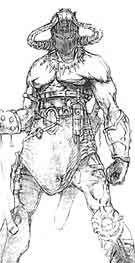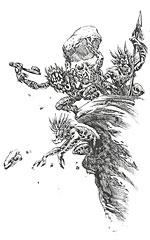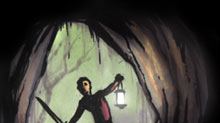Rune RPG Review
by Allan "Sven" Sugarbaker
Rune doesn't try to take on the entire fantasy spectrum. It focuses
instead on Norse mythology and the realm of the Vikings, who fight
daily against the evil influence of Loki and the coming of Ragnarok,
the end of the world. By concentrating on Vikings and only Vikings,
Rune does an admirable job of presenting the Norse experience in
all its fabled glory. Is it historically accurate? Nope, but you'll
be too busy looting and screaming your berzerk battle cry to notice.
 Derived from the excellent gene pool of Ars Magica's rules, Rune also
stands out on the game store shelves by embracing the competitive
nature of gamers, nearly unheard of in RPGs. Any player can win a
session of Rune, and I don't mean by killing the other characters.
To make things even more intriguing, there is no single person designated
as GM. Instead, all of the participants are expected to design and
run a section of the adventure, handing their Viking to another player
while they GM.
Derived from the excellent gene pool of Ars Magica's rules, Rune also
stands out on the game store shelves by embracing the competitive
nature of gamers, nearly unheard of in RPGs. Any player can win a
session of Rune, and I don't mean by killing the other characters.
To make things even more intriguing, there is no single person designated
as GM. Instead, all of the participants are expected to design and
run a section of the adventure, handing their Viking to another player
while they GM.
Let's take a closer look at Rune before Ragnarok is upon us. Only
those who know the ways of the Vikings shall be allowed to pass
into Valhalla...
Loot and Pillage
"Any warrior worthy of his own battle-axe is anxious to
prove himself to the gods, even if it means eclipsing his friends."
- Rune, pg. 91
A good portion of Rune is written with the assumption that not
only are the readers new to role-playing (an assumption most RPGs
start with, just in case), but also that they are more familiar
with computer game concepts than "off line" concepts.
This seems reasonable given that Rune was a computer game first.
Perhaps to make computer gamers even more comfortable, the Rune
RPG boasts some features normally reserved for the computer:
- A form of saving your character (called Death Insurance), in
which, for a small cost, the player can have a duplicate of his
pillager (minus equipment) hanging out at home.
- A preset, linear plotline.
- A detailed system to help GMs create additional adventures.
- The assumption that bigger weapons are better and faster.
And let's not forget,
- Earning points for gaining treasure and killing stuff.
Competitiveness, a holdover from the computer game, is at the
core of Rune. However, to tabletop RPGs, this comes as a novel idea.
Make the RPG competitive? Not just a friendly "I've got more
gold and magic than you" competitive, but rather a "I
have more points, so I played better" sort. The character who
earns the most points that session wins the day, literally. Vikings
are judged by every roll they succeed or fail at, gaining Victory
Points as they overcome obstacles and opponents. The parallels to
the computer game continue, as guidelines for league and tournament
play show players just how deep the rabbit hole goes.
You might be concerned that, considering each player's desire
to outshine his friends and win, goals requiring cooperative play
would be unreachable. This is not the case. The Rune rules want
the heroes to succeed, and help them to do so. In cases of tied
rolls against opponents, the tie goes to the Viking. The characters
are penalized for letting their companions die, and aren't allowed
to directly attack each other. Even when a Viking suffers his fifth
and final wound, a fatal situation, if someone can get to him immediately,
he may still live to pillage another day.
 But
wouldn't the GM be left out of the competition? If he ran more games
than he played in, wouldn't he fall behind in the league scoring?
Au contraire. The GM (called a Runner in Rune) has a different set
of conditions by which he scores Victory Points while running
the game. If a character fails his roll or gets heavily injured, the
Runner scores points. However, if the Runner kills a character,
he loses points (actually, everyone does, but the Runner gets the
worst penalty). This encourages the Runner to design encounters
that are dangerous and challenging, but not a wholesale slaughter.
But
wouldn't the GM be left out of the competition? If he ran more games
than he played in, wouldn't he fall behind in the league scoring?
Au contraire. The GM (called a Runner in Rune) has a different set
of conditions by which he scores Victory Points while running
the game. If a character fails his roll or gets heavily injured, the
Runner scores points. However, if the Runner kills a character,
he loses points (actually, everyone does, but the Runner gets the
worst penalty). This encourages the Runner to design encounters
that are dangerous and challenging, but not a wholesale slaughter.
Still, couldn't the Runner design adventure scenarios where it
was more likely for the Runner to gain points than it was for the
characters? Yep. In fact, Rune suggests that very thing to Runners
who get the hang of the Encounter design system (described below).
So, isn't that a major advantage for the Runner that the other players
would have a hard time overcoming? Not when Rune requires that each
player take an equal share of the Running. Everyone gets to be in
control of at least one Encounter (a small section of the overall
quest), ensuring an equal chance to abuse some Vikings for fun and
profit. In the spirit of fairness, the written adventure must be
shown to the other players once the Runner completes his section,
which would give other players the chance to learn new point-earning
tricks from their competition.
Ragnarok and Roll
"The sooner your character gets out into the world of adventure,
the sooner you can make him the envy of all of your opponents."
- Rune, pg. 15
When you first embark upon your pillaging career, your character
will be virtually identical to everyone else's. If this sounds like
every other RPG you've played, you haven't fully grasped the situation.
You won't merely be the same level, you'll also be of the same background,
same profession. Rune doesn't burden itself with a huge list of
character classes. You are a Viking warrior, and that's that. Using
the point-based system for building your character, you purchase
Characteristics, Abilities, and Hit Points with whatever's left.
The traits most useful to a Norseman on the warpath (Strength, Stamina,
Brawling, etc) cost a bit more, of course, but the trade-off is
a higher chance of winning.
Combat is the bread and butter of a Viking, and Rune takes steps
to ensure the right amount of challenge from each epic clash. Enemies
are rated by seven threat categories, ranging from Pitiful to Equal
to Terrifying. These categories give the Runner the proper ratio
of creatures to Vikings, determining the exact number of bad guys
to send into the fray. Not only that, but their stats are determined
by looking at the average stats of the characters, and making adjustments
according to the creature's description. These calculations should
be done before the adventure, if possible, to avoid slowing down
the action. Personally, I never know who's going to show up at my
games, so I have to wait until everyone arrives and do a head count.
Though I take issue with the biggest weapons affording the highest
initiative bonus, Rune passes my standard weapon test by giving
crossbows the healthy respect they deserve. Heavy crossbows tie
with two of the nasty dwarven weapons for dishing out the most damage
(other game systems should take note).
The gods rarely pay attention to mundane mortal activities, so
Rune allows characters to receive gifts from the gods whenever they
can pay the point cost. It doesn't matter what the Viking is doing
at the time. Falling off a cliff? Now's the time to grab that gift
from Njord, lord of the winds, to slow your fall. Players may find
themselves memorizing the Divine Gifts section to better understand
how to save their beloved Vikings.
Dealing Death By Design
"The severed arm is a weapon of opportunity, not something
you carry around with you." - Rune, pg. 52
The majority of the book is devoted to adventure design; more
specifically, it's devoted to Rune's Encounter design system. This
detailed, point-based process assures adventures to be "legal"
and, more importantly, balanced. However, learning the 106-page
design process could be a bit daunting to new GMs. The process covers
opponents, terrain, traps, treasure (mundane and magical), and types
of dice rolls.
The dice rolling definitions are a prime example of what might
scare off new GMs. As with any new RPG system, the concepts used
in gameplay may be familiar, but the labels assigned to those concepts
may not be. Every GM has asked for a variety of different die rolls
from his players, but rarely has one thought to name those methods.
Because the design system charges a different number of Encounter
Points depending on the type of roll he wants, Rune describes roll
types in detail. Say I've got a situation where I want the players
to balance their way across an icy ledge. Okay, so (flip, flip)
that means it's a "Multiple Roll: Endurance Test," which
will cost x amount of Encounter Points. If I make the difficulty
higher, the cost will go up.
 To
have a role-playing storyline closer to those in other RPGs, Rune
suggests using a Plotter. A Plotter is the closest thing Rune has
to a traditional GM, serving as the designer/runner that creates
the overall story connecting the encounters. More than just determining
the setting for the encounters, which is the only guideline given
in most Rune sessions, the Plotter designs and runs the first encounter
to set-up the story, the middle encounter to continue the plot's
development, and the final encounter to wrap things up in a big
climax. The other players run encounters in between the plot encounters
to fill out the rest of the quest. To help make the plot encounters
stand out even more, the Plotter gets extra Encounter Points to
design them with (+30% for the intro, +15% for the middle, and +50%
for the climax).
To
have a role-playing storyline closer to those in other RPGs, Rune
suggests using a Plotter. A Plotter is the closest thing Rune has
to a traditional GM, serving as the designer/runner that creates
the overall story connecting the encounters. More than just determining
the setting for the encounters, which is the only guideline given
in most Rune sessions, the Plotter designs and runs the first encounter
to set-up the story, the middle encounter to continue the plot's
development, and the final encounter to wrap things up in a big
climax. The other players run encounters in between the plot encounters
to fill out the rest of the quest. To help make the plot encounters
stand out even more, the Plotter gets extra Encounter Points to
design them with (+30% for the intro, +15% for the middle, and +50%
for the climax).
As a GM, I'll admit the collaborative GMing aspect of Rune makes
me a bit nervous. I know and game with quite a few role-players,
and several of them are GMs themselves. But in some cases, I haven't
seen their GMing style and skills yet, and don't know if they can
handle the job. Besides, they would each have to read the Encounter
design rules in order to contribute equally. Since it asks so many
gamers to take the reigns and be a Runner, Rune could benefit tremendously
from a GM screen. In fact, a quick reference for designing Encounters
would be on my wish list as well.
Fortunately, much of the design section is aimed toward hand-holding
new GMs through their task as a designer and Runner. The message
"Don't worry, it's easy" keeps urging new GMs onward to
meet their role-playing destiny. The official scoring rules penalize
any player that gives in to stagefright and doesn't run a section
of the adventure, effectively pushing nervous Runners out of the
nest. In our playtests, the Runner earned a substantial amount of
Victory Points, causing those who chicken out to miss out on the
potential gains as well. There's an eight page quick Encounter system
that creates basic scenarios, leaving players with no excuse for
arriving unprepared. If all else fails, Atlas hopes the book's repeated
message of "share your Encounters online" sinks in, allowing
new Runners to grab what they need off the web. Otherwise, players
like me may be limited to a very select group of Rune co-conspirators.
These Ain't Your Daddy's Vikings
"Yes, we know that real Vikings didn't wear horned helmets."
- Rune, pg. 205
In true Viking form, Rune casts aside the need to cling to realism.
If it's easier, more fun, or just more likely to receive a Viking's
approval, that's how the rules do it. Does it make sense that players
can save their character by buying Death Insurance? Not really, but it sure is more fun that
way. Who'd be able to throw caution to the wind and act like a Viking,
if they were too afraid of being knocked out of the group's competition?
Rune is less realistic than some RPGs out there. This is not a
bad thing; many are the game systems that only call for guns to
run out of ammo if it serves a dramatic purpose. The rules don't
delve into the deeper role-playing possibilities (they suggest Ars
Magica for that), tending instead to cater to fans of competitive
computer games. Role-players who try Rune should approach it with
the proper frame of mind: that Rune is the computer game without
the computer. Or perhaps, more appropriately, Rune is a new breed
of RPG -- the competitive tabletop RPG, which just happens to be
based on a computer game.
Rune has a couple of hurdles to get over before becoming a certified
hit. The casual gamer, who role-plays when it fits his schedule,
or the computer gamer, who is used to the machine doing all the
work, may be turned off by the process of encounter design. For
Rune to catch on, it not only needs to grab a few computer gamers,
it also needs to convert players into GMs, a step some players might
be unwilling to take. But Atlas Games has a history of providing
excellent support for their products, and the Rune concept has been
executed well. Rune succeeds admirably at three main objectives:
teaching the game, keeping the competition fair, and bringing out
the Norseman in all of us.




